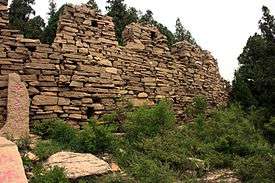Great Wall of Qi
The Great Wall of Qi (simplified Chinese: 齐长城; traditional Chinese: 齊長城; pinyin: Qí Chángchéng) is the oldest existing Great Wall in China.[1][2] Construction of the wall started in 441 BC (during the Spring and Autumn period) by the state of Qi, to defend itself from states of Jin and Yue and later on, from the Kingdom of Chu. Construction ended during the Warring States period.[3] The wall stretches from the areas under the administration of the present-day city of Jinan to the present-day city of Qingdao across the territories of the present-day cities of Tai'an, Zibo, Laiwu, Weifang, Linyi, and Rizhao.[3] Its total length has been estimated at about 600 kilometers.[4] Most of the wall is still able to be seen.

Dating
Before the discovery of the Tsinghua bamboo strips, several dates have been put forward as the date for the construction of the Great Wall of Qi. The earliest possible date is during the reign of Lord Huan of Qi (r. 685–643 BC) as mentioned in the Guanzi's "Qing zhong D" (輕重丁) chapter. However, the "Qing zhong" chapters of the Guanzi were in all likelihood composed no earlier than the Warring States period instead of the 7th century BCE work they purport to be, and thus could not be seen as a reliable historical source for the Spring and Autumn period centuries removed.[5]
The next date is 555 BC, which comes from the Zuo zhuan describing a Jin invasion of Qi that year which involved a Qi fortification, claimed by the Shui Jing Zhu to be part of the Great Wall of Qi. The Zuo zhuan itself, however, never used the term "great wall" (長城 changcheng) or referred to other fortifications along Qi's southern border, throwing doubts into this identification.[5]
The date 441 BC comes from the Xinian (繫年) collection of the Tsinghua bamboo strips, which were discovered from a Chu tomb in Hebei or Hunan and acquired by the Tsinghua University in 2008. Xinian was determined to be composed in the state of Chu no later than 370 BC, which puts it in good authority for the events it describes in its last four sections covering the period from 450 to 395 BC. Specifically, Xinian writes that Qi built the Great Wall "for the first time" after Zhao Huanzi (趙桓子) of Jin allied with the state of Yue to invade Qi.[6] This date accords well with other records of battles happening along the wall in 404 BC, 365 BC, and 350 BC from the Bamboo Annals[7] and inscriptions on the Piaoqiang bronze bells (𠫑羌鐘; discovered in Luoyang in 1928–1931).[8]
References
- Christopher Knowles (2001). Fodor's Exploring China. Fodor's, original from the University of Virginia. p. 56. ISBN 0-676-90161-1.
- Atlas of World Heritage: China. Long River Press. 2008. p. 74. ISBN 1-59265-060-0.
- Ancient sites from Zhou Dynasty discovered in the Qi Great Wall in Shandong Archived 2013-01-21 at Archive.today
- "List of heritage sites in Shandong" (in Chinese). Archived from the original on 2007-10-31. Retrieved 2009-08-17.
- Pines 2018, p. 745.
- Pines 2018, pp. 747-748.
- Pines 2018, pp. 745-746.
- Pines 2018, pp. 750-751.
- Pines, Yuri (2018). "The Earliest 'Great Wall'? Long Wall of Qi Revisited" (PDF). Journal of the American Oriental Society. 138 (4): 743–762.CS1 maint: ref=harv (link)